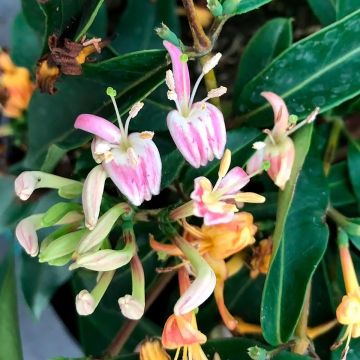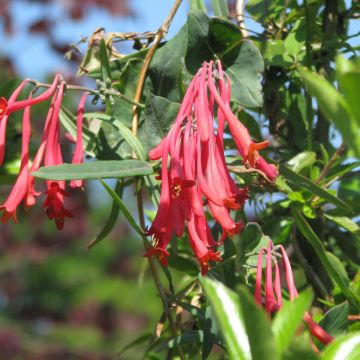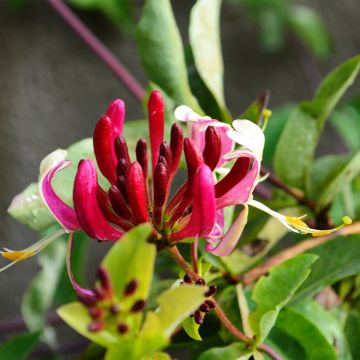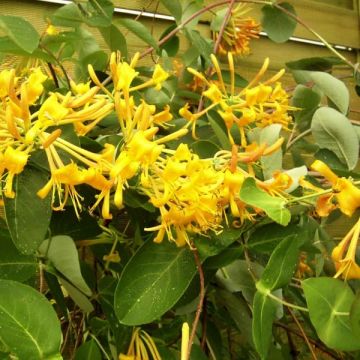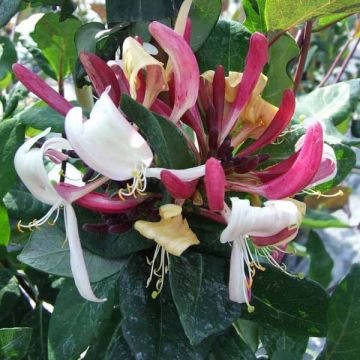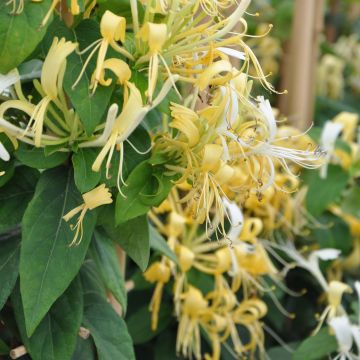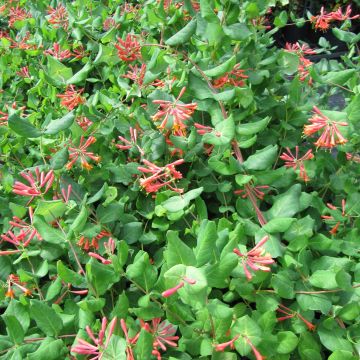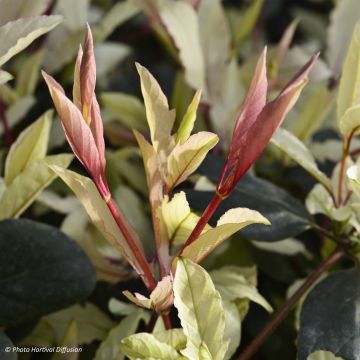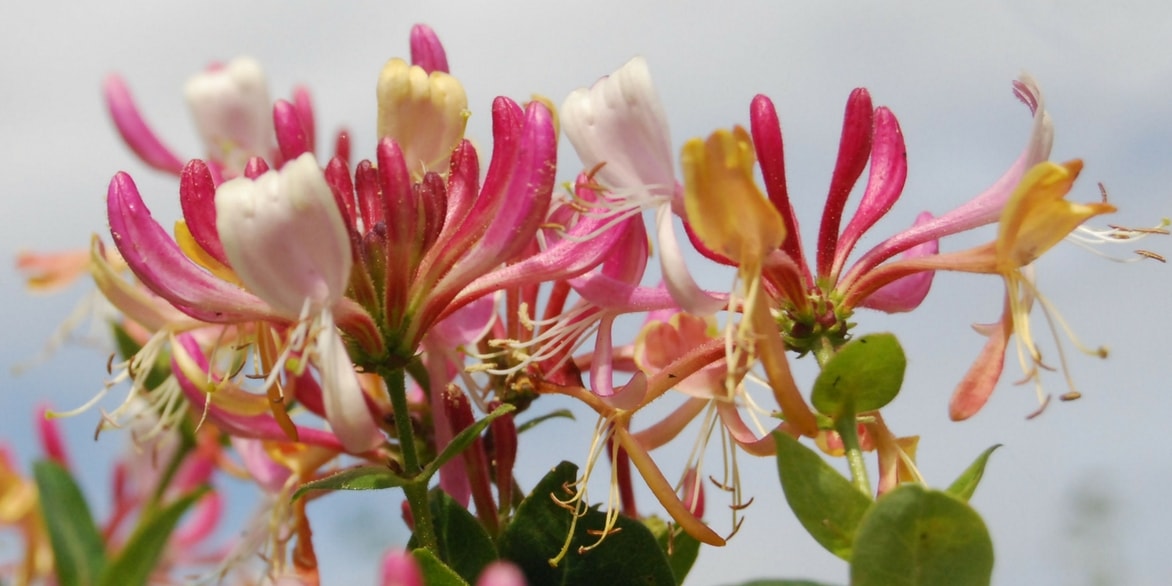
Honeysuckle: planting, pruning and maintenance
Contents
Honeysuckle, in a nutshell
- Honeysuckle is a charming climbing plant, its flowers emit an unmistakable fragrance.
- It is easy to grow, its growth is rapid and its flowering is very spreading depending on the species and varieties.
- It tolerates a wide variety of soils and climates.
- It requires little maintenance and is rarely affected by diseases or pests.
- It is perfect for quickly covering a trellis, a pergola, or for enlivening a single-species hedge.
- It can be grown both in the ground and in large pots and propagates easily by propagation by cuttings or layering.
A word from our Expert
The Honeysuckle (Lonicera) is well known to gardeners in its climbing form. A large woody and voluble liana, it boasts a unique fragrance during its flowering. This climbing plant is easy to cultivate, grows quickly, and offers real interest in winter, spring, or summer depending on the chosen variety or species. There are so many Honeysuckles that at least two or three are suitable for every situation, soil, and climate.
When climbing, the Honeysuckle sends out stems that can reach 2 to 10 m in length within a few months, allowing it to cover a trellis or fence. It features deciduous or evergreen foliage depending on the varieties and offers beautiful flowers in white, yellow, orange, pink, or red. These are generally very fragrant, especially in the late afternoon.

The Honeysuckle, while not one of those exceptional subjects to acquire at all costs, finds its place in every garden. It quickly becomes an obvious choice, thriving in partial shade or even in the shade, which it sometimes tolerates very well. Its success depends solely on careful planting, as this plant proves to be very tolerant of soil type. Very accommodating, it thrives equally well in a large pot or in the ground. It requires little maintenance, apart from annual pruning when it threatens to escape the space allocated to it.
Botany
Botanical data
- Latin name ”Latin
- Common name ”Common
- Flowering ”Flowering
Le feuillage, souvent décoratif et luxuriant, est composé de feuilles entières, lisses, de forme ovale à obovale, longues de 3 à 8 cm, parfois jusqu’à 15 cm chez le géant L. hildebrandtiana. Le feuillage est caduc, semi-persistant ou persistant, suivant les variétés mais aussi le climat. Les feuilles sont disposées de façon opposée sur les rameaux. Vert plus ou moins sombre, elles sont parfois joliment panachées comme chez le Honeysuckle ‘Harlequin Sherlite’.
La floraison, le plus souvent odorante par temps chaud et en fin de journée, s’étale de mai à octobre, selon les plantes. Les fleurs, composées d’un tube s’évasant en deux lèvres plus ou moins découpées, se distinguent par leur aspect très léger, presque aérien. Leur palette de couleurs, comprenant souvent le blanc, se décline en blanc jaunâtre, en rose, en orangé et même en rouge, dans des tons unis ou bicolores, parfois tricolores, changeant avec la maturité de la fleur. Cette floraison est mellifère et nectarifère, elle attire de nombreux insectes pollinisateurs.
La floraison est suivie par la formation de petits fruits ovoïdes et charnus de couleur variable. Ces baies, légèrement toxiques pour l’homme, font le régal des oiseaux.
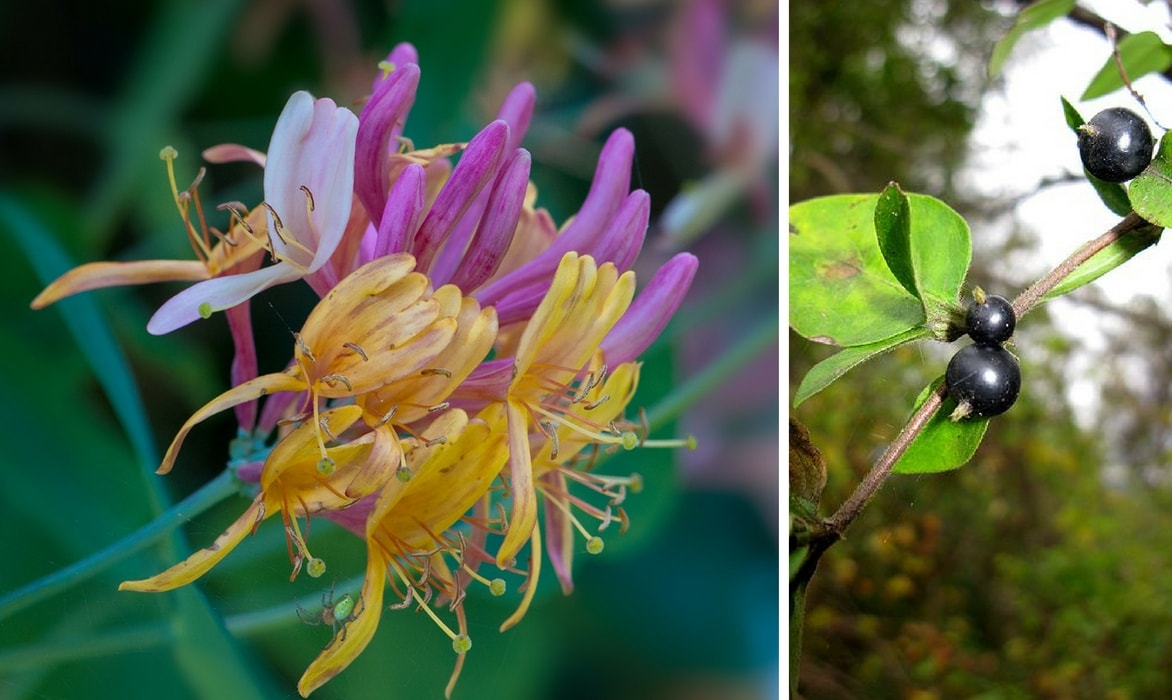
Honeysuckle: flowers, berries
Main varieties
Established in cold regions up to the tropics, often planted for its fragrance, honeysuckle comes in 200 climbing varieties, as well as bush varieties. Among the climbing types, here are some of the most commonly planted. Note that the most fragrant ones are often those that lose their leaves in winter.
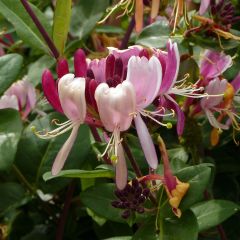
Lonicera periclymenum Serotina
- Flowering time August to October
- Height at maturity 5 m
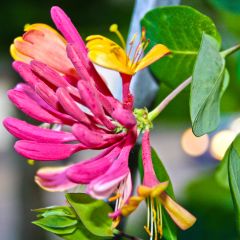
Lonicera x heckrottii Gold Flame - Goldflame Honeysuckle
- Flowering time July to October
- Height at maturity 3 m
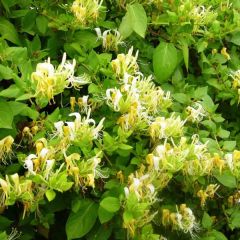
Lonicera japonica Hall's Prolific - Japanese Honeysuckle
- Flowering time August to October
- Height at maturity 6 m
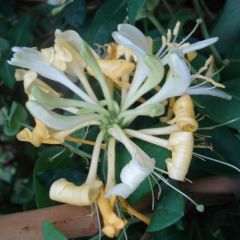
Lonicera periclymenum Scentsation - European honeysuckle
- Flowering time July to October
- Height at maturity 3 m
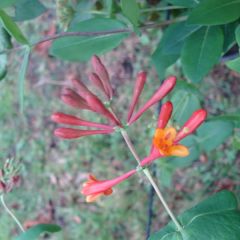
Lonicera x brownii Dropmore Scarlet
- Flowering time July to November
- Height at maturity 3,50 m

Lonicera henryi Copper Beauty - Henry's honeysuckle
- Flowering time July, August
- Height at maturity 2 m
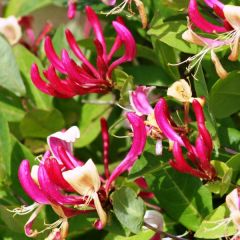
Lonicera periclymenum Fragrant Cloud - European honeysuckle
- Flowering time August to October
- Height at maturity 3 m
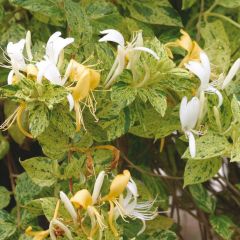
Lonicera japonica Mint Crisp
- Flowering time July to October
- Height at maturity 3 m
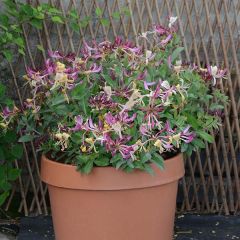
Lonicera periclymenum Chic et Choc - Common Honeysuckle
- Flowering time July to September
- Height at maturity 1 m
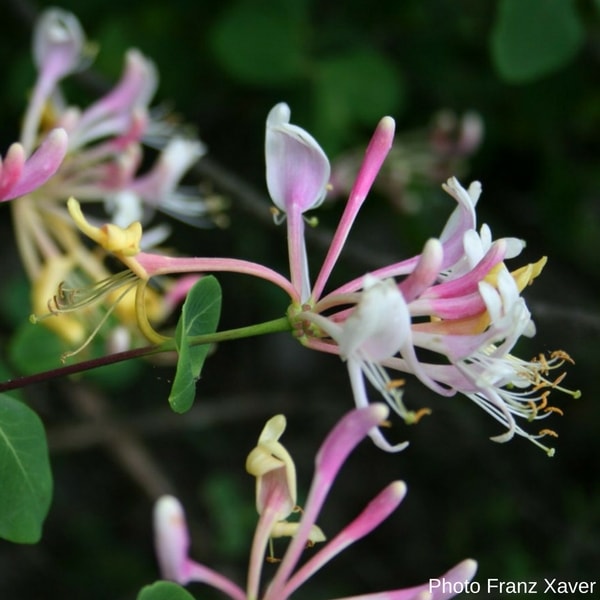
Lonicera etrusca
In dry soil, one can easily cultivate Lonicera etrusca, semi-evergreen with fragrant pink and yellow-orange flowers in June, and L. implexa, Mediterranean, evergreen with pale yellow flowers, white on the inside from May to July, slightly fragrant.
Finally, be aware that there are also many bush species and varieties, which make excellent ground cover or hedge shrubs like Lonicera fragrantissima, which blooms in the heart of winter, and L. tartarica which thrives in all our climates. The L. nitida and its varieties are valuable for quickly forming low and dense hedges with a very neat appearance.
Discover other Honeysuckle
View all →Available in 2 sizes
Available in 2 sizes
Available in 2 sizes
Available in 1 sizes
Available in 1 sizes
Available in 1 sizes
Available in 1 sizes
Available in 2 sizes
Available in 1 sizes
Available in 1 sizes
Young plantation
Where to plant Climbing Honeysuckle?
The cultivation of climbing honeysuckles is not particularly difficult; careful planting in deep, well-worked soil will lead to vigorous growth. The chosen exposure will generally be semi-shaded, away from the scorching rays of the sun, under foliage or against a wall facing east. It is especially important that the base of the plant is shaded and cool. In the northern parts of our country, planting in full sun is quite possible, whereas in warmer regions, semi-shade is essential.
Little sensitive to the acidity of the soil (neutral, acidic, or calcareous), honeysuckles do require varying degrees of moisture to support their flowering; they dislike overly poor and draining soils (very sandy or very stony, even rocky), or conversely, suffocating soils that are waterlogged in winter. Ideally, they should be reserved a soil rich in humus, well-drained, and retaining moisture in summer.
Hardiness varies depending on the species and hybrids, but most varieties commonly offered in commerce can withstand occasional frosts of around -15 °C.
The cultivation of honeysuckle in pots is entirely possible, although it is advisable to choose the less exuberant varieties. A large container with drainage holes, of at least 30 litres, and a light, fertile substrate, composed of a mix of potting soil and garden soil, should be selected, ensuring a layer of drainage material (gravel, clay balls) at the bottom of the pot. It is essential to monitor watering in summer and to provide slow-release fertiliser each year at the start of the growing season.
Honeysuckle is a climbing plant with voluble stems, unable to attach itself to its support. Its young green shoots will therefore need to be guided towards their support where they will be tied with soft ties. The plant will then find its way through the mesh of a trellis, among the branches of trees, or around the framework of a pergola.
As is the case with all young plants, watering should be followed for the first two years after planting to encourage good establishment.
→ Learn more with Olivier’s video: planting a honeysuckle
When to plant?
Container-grown climbing honeysuckle can be planted throughout the year, preferably during cooler, well-watered periods, and avoiding times of severe frost: from September to November in autumn, and from February to April in spring.
How to plant?
- Dig a hole equivalent to three times the height and width of the root ball. Loosen the bottom of the planting hole with a pick.
- Gently rake the root hairs at the edge of the root ball to facilitate exploration and growth of the roots released into their new substrate.
- Place the plant in the hole, slightly raising the collar of the plant, the intersection between the root system and the aerial stem, just above soil level.
- Fill in with a mix of potting soil and garden soil.
- Firm the soil around the plant well, creating a nice basin for watering.
- Water generously (at least 10 litres). Firm slightly.
- Water in the same way the next day, then a week later. During the establishment period of the plant, which lasts about 2 years, watering should be monitored, especially if it is dry and hot.
Generally, one honeysuckle plant is planted per square metre, as its vigorous growth will quickly cover a fence or bare trellis.
Read also
5 hardy climbing plantsPruning and maintenance
Easy to grow and maintain, the Honeysuckle will still benefit from a bit of attention to give its best, maintain its vigour, and enhance its flowering.
Pruning
While not essential, pruning honeysuckle may be necessary to balance the branches or thicken the habit: wait until the end of flowering to carry out this light pruning, as flower buds appear on the previous year’s wood in most species.
A bare plant can undergo severe pruning at the end of winter, before the resumption of growth.
Watering
Climbing Honeysuckle is generally not too demanding in terms of water, depending on the species and varieties, but it will always prefer cool soil, as it is sensitive to prolonged dry spells, especially when grown in pots.
Water regularly in summer and apply a thick mulch at the base of the plant in hot climates; this effective measure helps to space out watering.
Fertiliser applications
Like many plants, Honeysuckle will be more lush and floriferous if well-fed. An application of crushed horn or dried blood, first at planting and then once a year in spring, will promote vigorous growth and generous flowering.
Potential diseases and pests
Honeysuckle can be susceptible to aphid attacks, which can be treated with pyrethrin spray in the evening.
The main disease that may affect this plant is powdery mildew, also known as white mould, a pathogenous fungus that is quite specific to each plant species (tomato, vine, larkspur, etc.), capable of proliferating in cool or warm weather. The development of powdery mildew is recognisable by the appearance of whitish or greyish powdery spots on the foliage. Good air circulation in the centre of the plant, exposure where air flows, and preventive and curative treatment with sulphur are generally effective methods.
→ Christine explains in more detail the diseases and pests of honeysuckle
Multiplication
Climbing honeysuckles propagate easily by layering, by laying the stems on the ground while keeping them in contact with the soil, or by propagating semi-lignified cuttings in summer or lignified cuttings in autumn works very well.
Propagation by Cuttings
1st Case: using semi-lignified cuttings, in August:
- Using pruning shears, cut sections of vigorous stems from the current year, bearing two ranks of leaves. Trim the cuttings just above the first rank of leaves, and 1 cm above the second rank.
- Remove the lower leaves and insert the cutting into a mixture of potting soil and light soil, well moistened, up to the remaining leaves.
- Place 3 ‘supports’ in your pot, arranged in a triangle, then cover everything with a freezer bag, the base of which will be kept tightly adhered to the outer wall of the pot with an elastic band. This is the “forcing” technique.
- Keep the pots in partial shade, ensuring to occasionally add a bit of water to a saucer placed under the pot if the substrate seems to have dried out too much.
2nd Case: using autumn cuttings, in October-November, with or without leaves:
- Depending on the species or variety chosen: cut a portion of the current year’s stem about 30 cm long.
- Take the 30 cm sections just below a node.
- Keep only the last two ranks of leaves.
- Place the cuttings upright, in a row, in light soil, enriched with sand and potting soil, kept moist but not waterlogged, burying them two-thirds deep. Choose a sheltered position from cold winds.
Note: treatments for fungal diseases slow down the formation and growth of new roots.
→ Learn more in our tutorial: How to propagate honeysuckle?
Sowing
Sowing is possible, but the plant will take several years before flowering. Moreover, this technique does not allow for control over the appearance of the honeysuckle obtained in cases where several species or varieties, grown close to each other, may have hybridised through pollinating insects.
Association
Honeysuckles climb by entwining their stems around supports as varied as trees and sturdy arbors (for larger varieties), trellises, and fence panels. Robust and comfortable in all our regions, simple and graceful, they adorn the somewhat neglected areas of the garden with their unique fragrance, while sunny spots are generally reserved for Bignonia or Wisteria. The terrace or balcony can also boast a lovely specimen trained on a lattice or woven wood panel to obscure an unpleasant view or an awkward sight, etc.

Lonicera Heckrottii / Lonicera x americana and Wisteria sinensis
Annual Ipomoeas make lovely companions for Honeysuckles; even though they are ephemeral, they enhance their lush foliage throughout the beautiful season, and the style of their respective flowers is very complementary. Perennial sweet peas, which are so easy to grow, also pair well with their rustic character. Monospecific hedges, austere and composed of conifers or neatly trimmed laurels, will welcome these flowering lianas, full of resources and unpretentious, just as they will host Clematis, which share the same advantages and a comparable cultivation method.
→ Discover more ideas for pairing with honeysuckle in Christine’s advice sheet.
Did you know?
Honeysuckle, a melliferous plant, hosts a whole range of beneficial wildlife in the garden: various bumblebees, carpenter bees, and moths, particularly the Honeysuckle Sphinx, which pollinate it, attracted by the scent of the flowers intensified in the evening. It is also frequently visited by birds that relish its berries and help disperse the seeds.
It was formerly known as Caprifolium, which means “goat leaf” in Latin, due to the appetite these animals can have for its foliage. The caterpillars of day-flying butterflies such as the Azure Hairstreak or the Small Hairstreak also live and feed on its vegetation. Gourmands will appreciate the May Berry, Lonicera kamtschatica, a shrub and one of the few species that produces edible fruits for humans, whose berry resembles a large blueberry.
While the berries of Honeysuckle are generally toxic, the stem and bark are used in phytotherapy for their purifying and antitussive properties. The roots were once used to extract a blue dye. In perfumery, the Honeysuckle flower is referred to as the “silent flower,” as it is so low in essential oil that it cannot be extracted by traditional methods. It is therefore recreated from scratch by concocting a clever blend of molecules derived from chemistry. The fragrance of Lonicera fragrantissima is described as floral, sweet with jasmine notes, orange blossom, vegetal, and honeyed.
Useful resources
- On our site, our wide collection of climbing honeysuckles
- Discover Olivier’s video on the planting of honeysuckle
- Our advice sheet: How to propagate honeysuckle?
- Our advice sheets: 5 climbing plants that won’t damage walls; 6 ideal climbing plants for shading a terrace
- Find our selection of the most fragrant honeysuckles
- Our advice sheets: Honeysuckle, the sure values; Honeysuckle, the most beautiful varieties
- Advice sheet: choosing a honeysuckle
- Subscribe!
- Contents































